Tue Oct 28, 2008 9:13 pm
Cuffed prop this time around? Radio antenna mast too?
Just never looked quite right without those. Not that I'm complaining
Just never looked quite right without those. Not that I'm complaining
Wed Oct 29, 2008 12:57 pm
Dan,
I push for the antennae mast every chance I get but in reality, it's not going to happen. It's base is made to attach to a piece of structure that, if installed, would pose a very nasty head knocker and back gouger for the person climbing into the jump seat. It's pretty tight and thorny back there as it is and adding more poking/ripping obstacles is probably not a good idea. I've asked Mark to think about a way we can make it work but so far nothing reasonable has come up.
As far as the prop blades go, economics answered that question for us. When we were searching for a replacement prop, new built paddles from the Czech Republic were about $12.5k each. Good used paddles were about $6K to $8k each. Original cuffed blades were in the $15k each neighborhood if somebody can be found willing to give a set up. Albatross blades were in the $3k to $4k each range. They have rounded tips, are not cuffed but can be. When cuffed they look nearly identical to the original cuffed blades. The prop we bought has the Albatross blades in it, again, as a matter of economics. Because the cost of cuffing is around $3k per blade, we've made the decision to put that $12k to a more practical use than simple aesthetics. In the future if money becomes available, it could happen.
The bottom line is, the general public needs to understand that the CAF, much as it would love to be, is not in a position to restore its airplanes like many private owners with considerable wealth can. A painful reality. Those award winning airplanes that have everything in them and are finished so perfectly have set the bar so high that it's become unaffordable and often unpractical for others to meet. Unfortunately there are people in some circles that don't realize this or don't understand this. To them the top shelf, award winning restorations have become the normal expectation for all to meet. In reality, it's not realistic for the CAF, or other less affluent private owners to meet that bar if the desire is there to fly the aircraft in a reasonable amount of time. It is likewise not a reasonable goal if the plan is to fly the airplane 100 to 150 hours per year. And the final piece of the puzzle is, with a perfectly restored aircraft all decked out in its original regalia, most often there can be no jump seat to offer riders a peak inside what it was like to fly one of these machines 65 years ago. For the Red Tail Project, that's a large part of its mission.
During the rebuild we have added many additional pieces of original equipment not found in the airplane prior to this rebuild. Again cost, maintenance and ease of operation were all primary factors when deciding what we should and should not do realistically. With the exception of a few minor changes, the paint scheme will remain nearly identical to the that which it wore before the crash since it was designed to represent all of the Tuskegee groups. Some like it, some don't. The answer is, this project isn't about one person, it's about a group of people. It's hoped that the general public will embrace the airplane not as a technically correct masterpiece or the perfect recreation of a notable individuals aircraft, but as a nicely restored working Mustang that tells an inspiring story of a group of people that gave an awful lot to America and asked for nothing more than common respect in return for their efforts and sacrifice.
John
I push for the antennae mast every chance I get but in reality, it's not going to happen. It's base is made to attach to a piece of structure that, if installed, would pose a very nasty head knocker and back gouger for the person climbing into the jump seat. It's pretty tight and thorny back there as it is and adding more poking/ripping obstacles is probably not a good idea. I've asked Mark to think about a way we can make it work but so far nothing reasonable has come up.
As far as the prop blades go, economics answered that question for us. When we were searching for a replacement prop, new built paddles from the Czech Republic were about $12.5k each. Good used paddles were about $6K to $8k each. Original cuffed blades were in the $15k each neighborhood if somebody can be found willing to give a set up. Albatross blades were in the $3k to $4k each range. They have rounded tips, are not cuffed but can be. When cuffed they look nearly identical to the original cuffed blades. The prop we bought has the Albatross blades in it, again, as a matter of economics. Because the cost of cuffing is around $3k per blade, we've made the decision to put that $12k to a more practical use than simple aesthetics. In the future if money becomes available, it could happen.
The bottom line is, the general public needs to understand that the CAF, much as it would love to be, is not in a position to restore its airplanes like many private owners with considerable wealth can. A painful reality. Those award winning airplanes that have everything in them and are finished so perfectly have set the bar so high that it's become unaffordable and often unpractical for others to meet. Unfortunately there are people in some circles that don't realize this or don't understand this. To them the top shelf, award winning restorations have become the normal expectation for all to meet. In reality, it's not realistic for the CAF, or other less affluent private owners to meet that bar if the desire is there to fly the aircraft in a reasonable amount of time. It is likewise not a reasonable goal if the plan is to fly the airplane 100 to 150 hours per year. And the final piece of the puzzle is, with a perfectly restored aircraft all decked out in its original regalia, most often there can be no jump seat to offer riders a peak inside what it was like to fly one of these machines 65 years ago. For the Red Tail Project, that's a large part of its mission.
During the rebuild we have added many additional pieces of original equipment not found in the airplane prior to this rebuild. Again cost, maintenance and ease of operation were all primary factors when deciding what we should and should not do realistically. With the exception of a few minor changes, the paint scheme will remain nearly identical to the that which it wore before the crash since it was designed to represent all of the Tuskegee groups. Some like it, some don't. The answer is, this project isn't about one person, it's about a group of people. It's hoped that the general public will embrace the airplane not as a technically correct masterpiece or the perfect recreation of a notable individuals aircraft, but as a nicely restored working Mustang that tells an inspiring story of a group of people that gave an awful lot to America and asked for nothing more than common respect in return for their efforts and sacrifice.
John
Last edited by John Beyl on Wed Oct 29, 2008 1:49 pm, edited 2 times in total.
Wed Oct 29, 2008 1:35 pm
Thanks for the explaination.
I seem to recall, that when I used to get a chance to look around at this bird when it was in pieces next to Jack Sandberg's hanger in Crystal, that it had a cuffed bladed prop in the pile of parts. I imagine that went to another bird.
This one just holds a special place in me as it was the first Mustang I got close to, and 'snuck in' the cockpit when no one was looking.
Kids do that
Dan
I seem to recall, that when I used to get a chance to look around at this bird when it was in pieces next to Jack Sandberg's hanger in Crystal, that it had a cuffed bladed prop in the pile of parts. I imagine that went to another bird.
This one just holds a special place in me as it was the first Mustang I got close to, and 'snuck in' the cockpit when no one was looking.
Kids do that
Dan
Wed Oct 29, 2008 1:43 pm
Dan Johnson II wrote:Thanks for the explaination.
I seem to recall, that when I used to get a chance to look around at this bird when it was in pieces next to Jack Sandberg's hanger in Crystal, that it had a cuffed bladed prop in the pile of parts. I imagine that went to another bird.
This one just holds a special place in me as it was the first Mustang I got close to, and 'snuck in' the cockpit when no one was looking.
Kids do that
Dan
Dan,
It's not clear where the original cuffed prop went for this airplane. It was suggested that it went to Gunfighter after it's issue many years ago. When I spoke to Reg about it a couple years ago he told me the prop that was destroyed in that accident was not replaced with the C models. Regi's word has always been good enough for me.
John
PS: Are you the Dan Johnson that used to run Northland Air Cargo? If so, My brother used to rebuild engines for you back in the early 1990's
Thu Oct 30, 2008 12:32 am
John Beyl wrote:............... economics answered that question for us.
The bottom line is, the general public needs to understand that the CAF, much as it would love to be, is not in a position to restore its airplanes like many private owners with considerable wealth can. A painful reality. Those award winning airplanes that have everything in them and are finished so perfectly have set the bar so high that it's become unaffordable and often unpractical for others to meet. Unfortunately there are people in some circles that don't realize this or don't understand this.
John
John, I've been using WIX for only a couple months, but I quickly discerned that there are quite a few WIXers who need to "take a bite of the reality sandwich" when it comes to restorations. Your post did an excellent job of explaining a bit of fiscal reality without being offensive to any but the most thin-skinned.
I'm off the soapbox now.
Thu Oct 30, 2008 3:42 pm
Modern rebuild as opposed to just pick up the bit needed from supply!
I do understand that some folks in their eagerness to be historically correct often do throw a bit of a "hissy fit" when they see things are not quite "correct"! I try not to do that with A/C restorers as it IS THERE MONEY and THEIR AIRCRAFT. Of course it does make it harder for me when trying to do my artwork because I often look at New pics of rebuilds as well as fuzzy old B&W pics. I have been thrown off more than once by post war "adjustments"
Keep up the good work. Paint it the way you want to, put on the prop you can afford, and as for the jumpseat vs a big chunky radio and mast-I'll take that ride!

I do understand that some folks in their eagerness to be historically correct often do throw a bit of a "hissy fit" when they see things are not quite "correct"! I try not to do that with A/C restorers as it IS THERE MONEY and THEIR AIRCRAFT. Of course it does make it harder for me when trying to do my artwork because I often look at New pics of rebuilds as well as fuzzy old B&W pics. I have been thrown off more than once by post war "adjustments"
Keep up the good work. Paint it the way you want to, put on the prop you can afford, and as for the jumpseat vs a big chunky radio and mast-I'll take that ride!

Mon Nov 10, 2008 7:24 pm
deleted
Last edited by Old SAR pilot on Tue Dec 30, 2008 12:57 pm, edited 1 time in total.
Wed Nov 19, 2008 3:51 pm
Well we went up to Wahpeton on Saturday. Spent the day putting tubes in the tires, mounting the tires on the wheels, and scotch-brighting countless rivets on the fuselage. The fuselage should be painted the next time we go up.
That night, the rest of the crew went up to check on the progress of the wing and John sent me these shots of it.
We are getting closer!



That night, the rest of the crew went up to check on the progress of the wing and John sent me these shots of it.
We are getting closer!



TA
Sun Nov 23, 2008 4:55 pm
Great job by all involved........ Looks superb! I know Rosie and everyone else just can't wait for the wing to be completed and then mated to the fuselage....... To Bryan and John B, thanks for the updates..... Alan
Tue Dec 16, 2008 4:55 pm
where will the airplane be based and with whom?
Wed Dec 17, 2008 8:40 am
Enemy Ace wrote:where will the airplane be based and with whom?
The airplane is assigned to the Minnesota Wing of the CAF, based at South St Paul's Fleming Field.
It will join our B-25 "Miss Mitchell", Harvard, BT-13, L-5, and PT-22.
Fri Dec 19, 2008 8:32 am
The gang at TriState sent us an early Christmas Present. We were supposed to head up there last weekend, but the weather made us change our plans. Here is what we missed:
Primer:



Silver:



Markings:





Finished product:


Primer:



Silver:



Markings:





Finished product:


Fri Dec 19, 2008 9:15 am
Hi Bryan,awesome christmas present,I hope Santa has one in the bag for me!!!  Best wishes for the continued rebuild progress into the new year and I loved the DVD,cheers,Pete
Best wishes for the continued rebuild progress into the new year and I loved the DVD,cheers,Pete 

Fri Dec 19, 2008 1:29 pm
Lookin' good! 
Wed Feb 04, 2009 9:13 pm
bump 